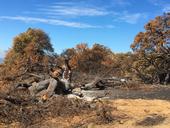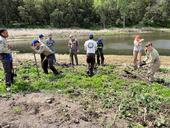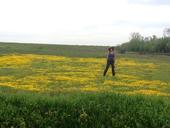- Author: Sonia Fernandez, UC Santa Barbara

Naturally fire-prone ecosystems tend to have more species of birds and mammals, new study reveals
Wildfires. Many see them as purely destructive forces, disasters that blaze through a landscape, charring everything in their paths. But a study published in the journal Ecology Letters reminds us that wildfires are also generative forces, spurring biodiversity in their wakes.
“There's a fair amount of biodiversity research on fire and plants,” said
- Author: Adina M Merenlender

When Al Murphy first took the reins at the UC Hopland Research and Extension Center (HREC) back in the 1950s, he had the joy of listening to California red-legged frogs living in a couple of perennial ponds. Maybe it was the frog chorus or just the rarity of year-round water that made Al and his staff decide to keep the sheep out and declare the ponds a biological area. Despite the designation as a biological area, the ponds have lost a good deal of biodiversity since Al's time.
The native frogs took a beating thanks to bullfrogs and exotic fish such as large-mouth bass that were introduced for sport fishing and...
- Author: Mike Hsu

Giving 1,200-pound cows access to one of California's most fragile and biologically rich ecosystems seems a strange way to protect its threatened and endangered species.
But a recently published study suggests that reintroducing low to moderate levels of cattle grazing around vernal pools – under certain conditions – leads to a greater number and greater variety of native plants.
“We found that after 40 years of rest from grazing, reintroducing conservation grazing had – across the board – positive impacts on vernal pool plant diversity,” said Julia Michaels, a visiting professor at Reed College who led a
- Author: Jacob Shea, jacob_shea@berkeley.edu

Around the world, countries have established protected areas as the primary defense to reduce widespread biodiversity loss and guard vulnerable habitats. However, species and ecosystems are adapted to particular climates—as those climates shift across and outside of protected area boundaries, species may track them into unprotected landscapes where human land uses degrade conservation potential.
In a new study published in Science Advances today, Berkeley researchers offer a broad analysis of how protected areas will continue to capture the...
- Author: Brook Gamble

From the 13,400 monarch butterflies currently overwintering in Pacific Grove’s Monterey pine trees, to the salmon migrating upstream from the ocean to their natal river in our watersheds, to the western fence lizard doing pushups on your concrete curb, we are always surrounded by nature in this state. California is one of the most biologically diverse places on Earth, providing a home for over 30,000 species of insects, 63 freshwater fish, 46 amphibians, 96 reptiles, 563 birds, 190 mammals and more than 8,000 plants!
E.O. Wilson, conservation biologist, sociobiologist, and the world’s leading authority on ants says that “Nature holds the key to our aesthetic,...



